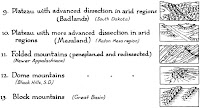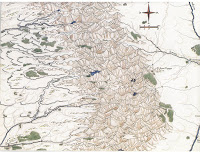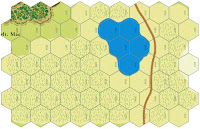 I just discovered this post over at John Krygier’s absolutely fascinating Making Maps: DIY Cartography blog. The application to both role-playing and wargaming is obvious. These terrain features really remind me of the old Iron Crown Enterprises maps– those things were absolutely gorgeous.
I just discovered this post over at John Krygier’s absolutely fascinating Making Maps: DIY Cartography blog. The application to both role-playing and wargaming is obvious. These terrain features really remind me of the old Iron Crown Enterprises maps– those things were absolutely gorgeous.
 The listing of those fifty terrain types– with no fewer than ten different types of “plains” and includes representative art for all of them– comes from a 1931 article by Erwin Raisz (of whom I had never heard before), who sets out a system to standardize the illustration of terrain according to the geographic type of the area, but with incorporating the peculiar idiosyncracies of the land itself. Raisz is quoted as saying:
The listing of those fifty terrain types– with no fewer than ten different types of “plains” and includes representative art for all of them– comes from a 1931 article by Erwin Raisz (of whom I had never heard before), who sets out a system to standardize the illustration of terrain according to the geographic type of the area, but with incorporating the peculiar idiosyncracies of the land itself. Raisz is quoted as saying:
For the study of settlement, land utilization, or any other aspect of man’s occupation of the earth it is more important to have information about the ruggedness, trend, and character of mountains, ridges, plains, plateaus,
canyons, and so on-in a word, the physiography of the region.
And I can say that such would be eminently important to the more mundane aspects of both role-playing and wargaming. On the whole, it’s very evocative of Renaissance-era maps, to my eye. It is most definitely the antithesis of modern cartography, which is very modern and scientific, with elevation lines and so forth. Much as I can see the appeal of such a modernist approach to mapping, I vastly prefer the evocative nature of this sort of cartography for gaming purposes.
The old Wilderlands maps are something of an adaptation of this sort of map-making; taking these sorts of naturalistic terrain markers (in a simplified form; mountains are mountains) and applying a hex map overlay. The famed Greyhawk poster maps by Darlene are more of an abstraction of that principle; the terrain types, to a large extent, are made to conform to the hex  grid (although she does do so in a very aesthetically pleasing way, as well as the way she works the necessary text of the map in with the features they describe). At the other end of the scale, of course, are more traditional wargaming maps (of the AH or SPI school), where the terrain is laid out at the hex level in an almost-abstract fashion.
grid (although she does do so in a very aesthetically pleasing way, as well as the way she works the necessary text of the map in with the features they describe). At the other end of the scale, of course, are more traditional wargaming maps (of the AH or SPI school), where the terrain is laid out at the hex level in an almost-abstract fashion.
Krygier also makes the point that this sort of cartography is largely impossible with today’s modern digital cartography. I’m not convinced that something reasonable couldn’t be done in the Raiszian style, but I hardly claim to be an expert in digital cartography.
All in all, I find myself now inspired to do a whole lot of mapping for my campaign.









Wow. That post leaves me wishing I were a lot more artistic to produce maps like that. Just the key of terrain types is evocative itself.
P.S. Have you considered an article or series of articles on how one gets into the canon of Greyhawk, and what belongs to what? There’s so much there, how does one even begin?
Have you considered an article or series of articles on how one gets into the canon of Greyhawk, and what belongs to what? There’s so much there, how does one even begin?
Not sure what you’re referring to here, restless. You mean actually finding or purchasing the stuff?
Not in regards to acquiring it. I have a lot in print (to my wife’s chagrin) and PDF (perhaps most from 0e through 2e, and quite a bit after that), and I’m no stranger to the trading/sales forums and auctions. However, there’s so much territory to cover on the actual topic of the WoG, from the basic information in the folio or boxed set and modules and notes from EGG’s campaign in the magazines, to the resources online, continued quasi(?)-canon items (like Castle Zagyg, Rob Kuntz’s new material, the novels, etc.), later editions and so forth. It’s pretty intimidating.
Back in the day my friends and I made our own settings, and now it seems that there’s so much material on Greyhawk I don’t even know what is the best place to begin studying it. Also, I get the impression that there’s likely a certain order or path to take in consuming it to get the proper old school flavor, and it might not necessarily be the order of publication.
I surely can’t be alone in being bewildered by the sheer volume of material and what’s the best route to take with it! It almost seems like somebody could do a multi-volume set on the history of Greyhawk and meta-notes on canon changes, etc.